This incredible video of a Eurasian lynx and her cubs, taken at Langedrag Wildife Park in Norway, was very generously sent to us by Per Johan Naesje. Thank you so much for sharing!
Learn more about the Eurasian Lynx on our fact sheet.
Working for the smaller wild cats
This incredible video of a Eurasian lynx and her cubs, taken at Langedrag Wildife Park in Norway, was very generously sent to us by Per Johan Naesje. Thank you so much for sharing!
Learn more about the Eurasian Lynx on our fact sheet.
The conservation status of the smaller 28 wild cat species varies widely. Earlier this month the IUCN revised their Red Data List, so an update to our Status of Wild Cats chart was in order. There were a few surprises.
Geoffroy’s Cat – This cat is widespread and abundant throughout its range, in all habitats. Its distribution range is continuous, meaning there are no isolated populations. Perhaps the most important factor in their new listing as Least Concern is the fact that these cats have adapted to the conversion of sub-tropical forest into croplands, and seem to be fairly tolerant of habitat alteration. Much like the Bobcat in North America, these cats appear to be adaptable to new situations, and their population is now considered Stable.
Iberian Lynx – This beautiful cat has actually been down-listed. Previously classed as Critically Endangered, they are now classed as Endangered, with an increasing population. Of the 37 wild cat species, this is the only one whose population is increasing, due to the enormous efforts of the people involved in their breeding and reintroduction. They are a perfect example of humans saving a species if the will and the effort is there.
Sand Cat – In 1996, these small cats were classed as Least Concern. In 2008, and again in 2015, they were classed as Near Threatened. In each of the classification years however, their population trend was and is listed as Unknown. In this day of camera traps and wildlife cameras, no one actually has any idea how many sand cats there are. Are they endangered? Are they common?
Sand Cats are native to Algeria; Egypt; Iran, Islamic Republic of; Israel; Jordan; Kazakhstan; Kuwait; Mauritania; Morocco; Niger; Oman; Pakistan; Saudi Arabia; Syrian Arab Republic; Turkmenistan; United Arab Emirates; Uzbekistan; Western Sahara; Yemen. The geopolitical situation in many of these countries explains the serious lack of field studies on these cats.
It is very difficult to find good news in the conservation world, so we’ll close with a list of the ten NON-endangered small wild cats:
You can read the complete wild cat list on our Status of Wild Cats page.
Text and photos by Sebastian Kennerknecht
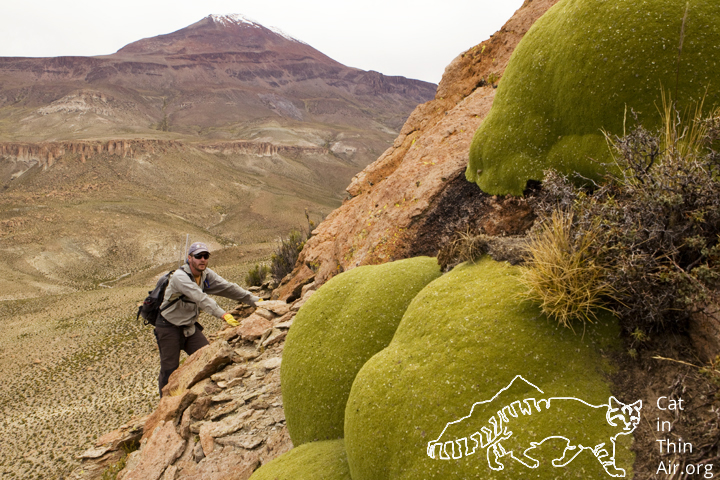
An Andean Cat slowly walks along a ridge in the high Andes. A camera’s shutter clicks. The cat pauses to see where the noise is coming from. The camera takes a few more pictures. Curious, the feline approaches and cheek rubs the waterproof case surrounding the camera. I wake up.
That’s the dream I had while sleeping in a tent in western Bolivia while working on the Cat in Thin Air project. My name is Sebastian Kennerknecht and for years I have dreamed of photographing the Andean Cat to then use those pictures to aid in their conservation. To make this a reality I teamed up with the amazing biologists of the Andean Cat Alliance and created the Cat in Thin Air project.
The goal of the project is simple: help ensure the survival of the Andean Mountain Cat through education on a local and global scale. The method was also simple at least in concept: photograph the ecology of the cat, the human caused threats the cats face, as well as the conservation actions being taken to protect this animal, to then tell the Andean Cat’s whole story to be shared with the world.
So it was time to head to Bolivia and Argentina to meet up with the researchers who have been studying the species for years.

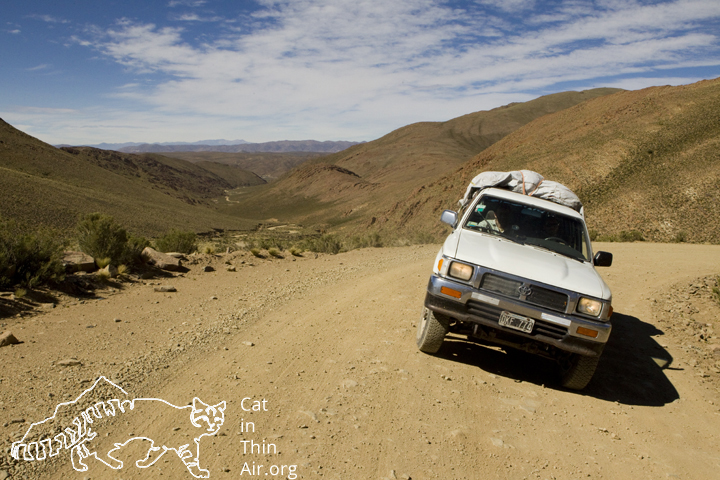
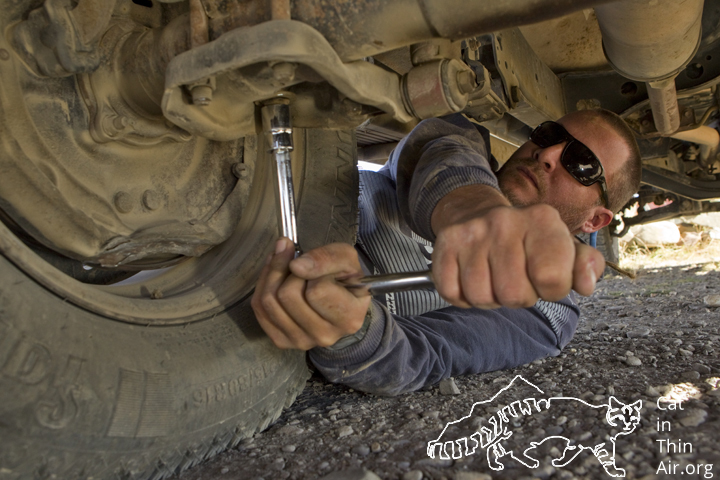
Once we arrived at the study site the beauty of the area became more than obvious.
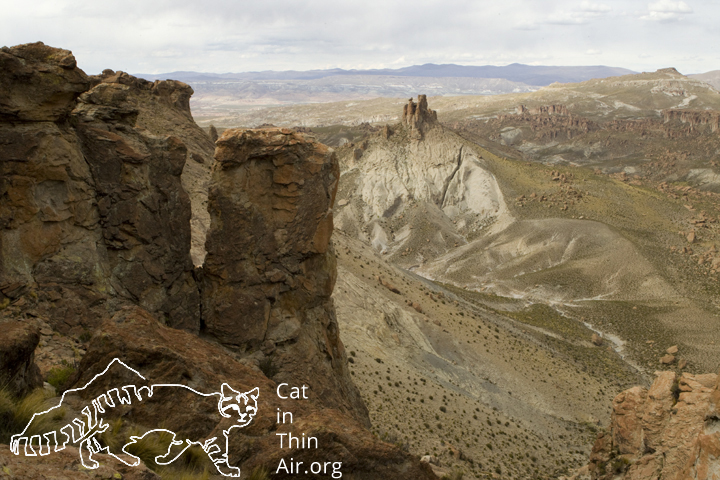
So how do you photograph a cat species that most researchers studying the species have never even seen themselves? The answer is simple: SLR camera traps. Imagine a professional camera connected to two flashes all of which are connected to a triggering device that activates the camera when an animal passes through an invisible beam.
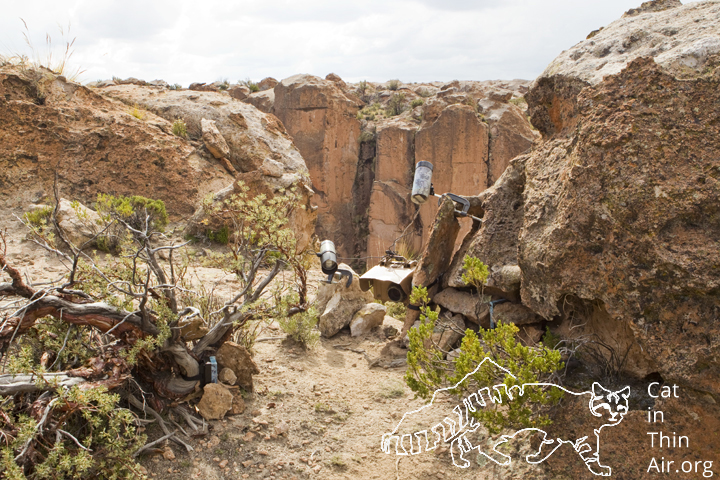
All of the biologists, including Juan Reppucci, Cintia Tellaeche, Mauro Lucherini, Alejandra Torrez, and Juan Carlos Huaranca, being the amazing people that they are put their research projects on hold and helped me not only set up these camera traps but also schlep them up the mountain.
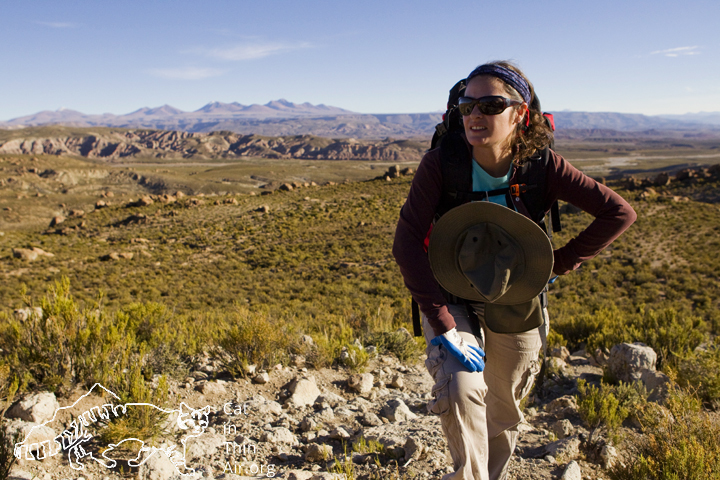
We placed four of these camera trap set-ups to try and get pictures of these elusive cats. After that it was time to be patient and focus on the other photographs (like the threats and the biologist’s research — – but sadly if I write about that here, this post will simply get too long). After five weeks we collected all the traps and checked the results of the cameras.
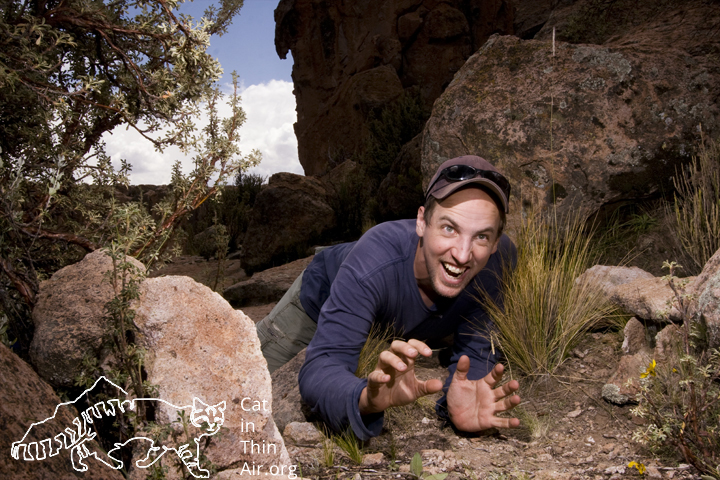

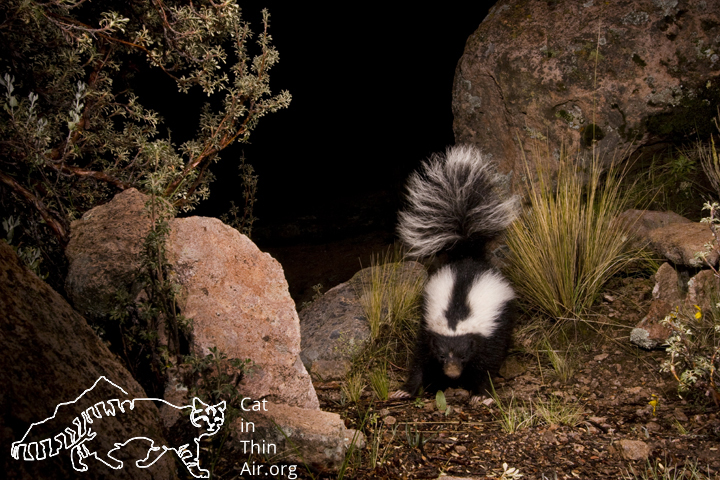
Whenever I go on assignment to try and photograph a wild cat species (in the wild!) that hasn’t been photographed a whole lot, looking through the camera trap images is both nerve racking and extremely exciting. Getting pictures of a fox and a skunk was of course more than great, but it wasn’t the goal of the project. When I saw a picture of an Andean Cat on the back of the camera, all my fears went right away (due to multiple reasons we can’t publish this image yet); and that image was followed by the discovery of a Pampas Cat.
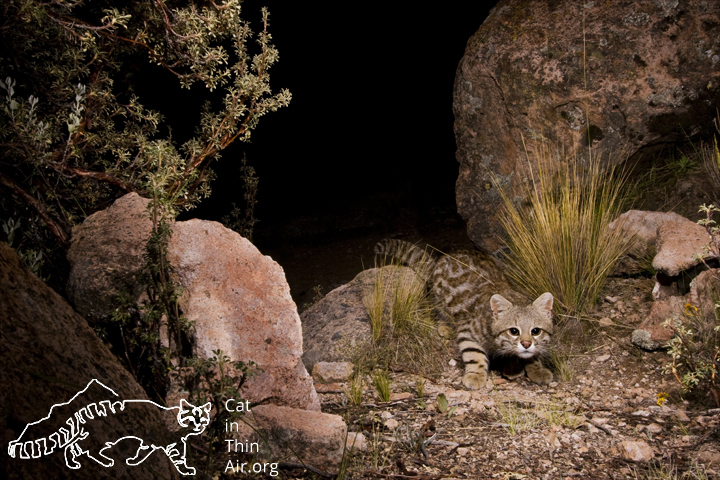
All our efforts were rewarded by this single picture. This will hopefully be the first of many pictures of the cat species found in the Andes. Only time will tell as I will return to South America next year. If you’d like to find out more about the Cat in Thin Air Project, please visit: http://catinthinair.org/ . Finally, I’d like to also make sure Lilian Villaba is acknowledged for all the work she put into making this project a reality!
By Ricky Reino
This post is about my most recent trip – a weekend to Thailand to spend time with flat-headed cats!
Flat-headed cats are a little known species, native to some parts of south east Asia, such as the island of Borneo. They are specialised fish hunters and are classed as endangered on the IUCN Red List.
Around a year and a half ago I saw via the internet that there were a handful of flat-headed cats kept in captivity in Thailand, and so decided to get in contact with these collections.
It took a while of being passed between email addresses, but finally I was put in contact with the animal manager of a well known zoo not too far from Bangkok.
I explained through our conversations about myself and my interest in spending time with the zoo’s flat-headed cats to get a small glimpse at their behaviour and learn how they are managed by their keepers; but also offered to help bring ideas on enrichment etc – this was greatly accepted and we started to discuss things further.
I had to write an official letter, with proof of my professional history, to the director of the zoo, who accepted my request and sent me an official invite which was fantastic, and after that I was able to start planning.
I didn’t have anyone that was able to come with me from the UK, but as it was my cousin was travelling around Thailand with his girlfriend at the time so we all arranged to meet at Bangkok airport upon my arrival and go from there.
September 2014 arrived, and after a very long (not made better by a very loud, drunk man in the seat behind me) flight, I made my way through Bangkok airport, got screened for Ebola, passed through customs and then found my cousin.
The animal manager of the zoo was also waiting at the airport in one of the zoo vehicles, and drove my cousin and I the hour journey to the zoo, passing my massive traffic jams, and little villages, eventually moving into beautiful lush green forest.
As soon as we got there I was shown to my very own apartment (they were really taking care of me!) where I had time to freshen up then we were taken to meet the director. Both myself and my cousin were given the warmest of welcomes and also gifted a lovely book all about the animals kept at the zoo with some incredible pictures in it.
I was itching to see the zoo, so the animal manager drove us round taking us to see lots of animals such as the elephants, and the clouded leopards – which are another species of small cat, and an incredibly beautiful one at that! The zoo has a great breeding program for this species, working with other zoos globally to move on youngsters to spread the genes. I was privileged enough to be given the opportunity to interact with some young hand reared clouded leopards after meeting with the head keeper of these cats, which was fantastic. They were so full of life and so so agile running around and jumping out of the trees, running along the ground, bouncing off my shoulders then leaping back into the trees.
We were shown around the rest of the cat section, but as it was getting late we didn’t have much time so were taken back to the apartment and then taken for dinner at a beautiful wooden tower overlooking the forest about 20 minutes away from the zoo.
Unfortunately that night I became VERY ill, and had to rearrange plans and flights to come home as soon as possible. I was really glad that my cousin was there as he made sure I was OK and kept me hydrated etc.
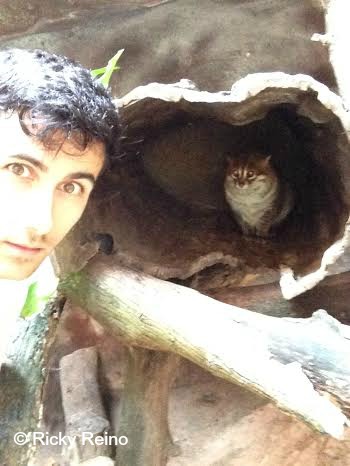 Next morning, I forced myself to get up to do what I had travelled all the way to Thailand to do, even if it was just for the day rather than for a week as planned. I met the head cat keeper and was taken to the enclosure where the flat-headed cats were.
Next morning, I forced myself to get up to do what I had travelled all the way to Thailand to do, even if it was just for the day rather than for a week as planned. I met the head cat keeper and was taken to the enclosure where the flat-headed cats were.
The first thing that struck me was the smell (which didn’t help when I wasn’t feeling great!) – lots of small cats have a strong smell, but this was a very different & strong smell. The zoo kept two males, one of which was hand reared. The cats clearly didn’t have much interaction with their keepers as they both stayed in their hollowed out log shelter, just watching what we were doing.
I went around the enclosure cleaning up the cats’ mess, raked their substrate and scrubbed out & refilled their pond as we were going to put their food ( a fish each) in there later that day. One of the cats came out of the resting place and walked over to the freshly cleaned pond once I had moved away from it, and interestingly I noticed that as he walked around, he was constantly letting out a very fine stream of urine, as a way of spreading his scent – this is probably why the smell in the enclosure was so strong!
It was interesting to really see the physique of this species when the cat was up and about.. a very short, round shape with a short and flattened tail. wide, webbed paws with claws that stuck out, just like those of the very closely related fishing cat. This species mainly hunts fish, so these physical adaptations help it hunt in and around the water. It was interesting to see just how flat the top of this cats’ head was too.. the reason why it is called the ‘flat-headed cat’.
Due to my changed flight schedule, I had to leave the flat-headed cats and the zoo, despite not having spent as much time there as I would have liked. I travelled back to the airport and said goodbye to my cousin and his girlfriend so that I could catch my flight home.
I keep in contact with the animal manager, and am very thankful at being given the opportunity to spend some time, however short it was, with one of the most endangered cat species on the planet. The opportunity for me to back to the zoo to spend time learning more is there, and I will definitely be going back in the future.
Thanks for reading!
Ricky
See also Flat-headed Cat
February is our year end, and thus our favorite month here at ISEC Canada. This is the month when we get to give all our money to the small wild cats.
We are overjoyed to have sent $20,500 CAD to the Black-footed Cat Working Group, as a result of our fall campaign to raise funds to replace their old truck. Studying these tiny desert dwellers requires thousands of hours of driving through some pretty rough areas. Now, due to of the generosity of our donors, scientists can continue learning how to help these cats.
In addition, we sent $26,500 CAD in allocated donations to the Small Cat Action Fund of Panthera. They will equally match these funds, resulting in even more field work grants to small wild cat researchers.
What this means, of course, is that we need to start collecting money again. If you’re in the mood to donate to small wild cat conservation, please see the Donate Now button on the right! 😉
By Ricky Reino
With this post I’m going to tell you about my ‘Weekend to Africa’ to spend time with an African golden cat!
African golden cats are most definitely the least known of all the African cat species, and there haven’t been many recorded in captivity, with the last known ones passing away many years ago.
In 2014 after some months of communication (having had to majorly brush up on my French), I was invited to a private sanctuary in Central Africa by a lady who happened to keep what I think may be the only captive African golden cat. I booked my flights for March, and asked my dad to come along too as Central Africa wasn’t a place that I wanted to go to alone.
One long and bumpy plane journey later we arrived safely and were taken to the sanctuary, which was through the local village, down a dirt track and behind a big set of metal gates. Despite being extremely tired from the journey and the shock to the system of being in such a high humidity area (after coming from a very rainy London) I was itching to see the cat, but it was 2am so everything was in darkness.
Once we had had the chance to catch up on sleep the owner showed us around the grounds and explained why she had the various animals there. Animals such as the golden cat, some mangabey monkeys, mongoose, civets, various small hoofed animals and a 4 year old gorilla were all victims of wildlife crime and as the owner worked for the government, she took them in to her sanctuary.
Having grown up with western zoos, enclosures here weren’t to the standards that I was used to, but the owner and her staff showed as much passion and enthusiasm for the animals as any keeper that I have worked with. I was shown plans for a brand new ‘semi-wild’ site that was being created deep in the forest that the animals would move to so they weren’t near to people, and was asked to design a better enclosure for the African golden cat, with the ability to hold more than one in case others were to be rescued. I felt privileged to be asked this and got on with designs straight away.
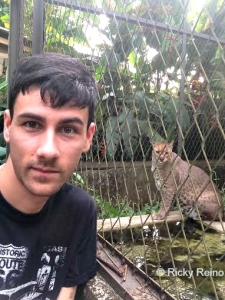 My weekend at the sanctuary was mostly spent sat by the side of the African golden cat enclosure, completely mesmerised by how stunning it was.
My weekend at the sanctuary was mostly spent sat by the side of the African golden cat enclosure, completely mesmerised by how stunning it was.
It was a 4 year old male that the owner took in at a young age, due to villagers finding him on his own at the edge of a forest who then handed him over to police.
He was a solidly built cat, a little bigger than a caracal (which it is closely related to genetically) with a reddish/grey coat, a white underside and faint markings along his sides & belly. He had huge feet, long back legs, a shorter tail and amazing crystal blue eyes.
Despite having been in a captive environment from a young age, he showed lots of interest and natural stalking behaviour in the various hoof stock species roaming freely in the area next to his enclosure. He would also readily leap up the branches in the enclosure to try and catch wild birds that landed on his roof.
He wasn’t as aggressive as I had expected him to be, although he would hiss if I shuffled position (mainly due to the ants that were climbing into my shorts!) He was actually quite interested in what I was doing, and I have a lot of great pictures of his big pink nose, where he would put his face up to the camera just as the photo was taken!
With the keeper, I went in to the enclosure to clean up his mess and any food left overs, and although the cat was confident when there was a fence between us, he stayed out of our way when we were cleaning up, though we did have a broom at hand to keep him at distance if we needed to.
Whilst in the enclosure I took the opportunity to spray some of the owner’s perfume on a tree stump, as a bit of sensory enrichment, which is something that we do quite often in western zoos to keep our captive animals stimulated. As soon as we left the enclosure the golden cat investigated the new smell and displayed lots of similar behaviours to other cats that I have done this enrichment with – lots of head and body rubbing around the stump and then spraying over it and walking round his territory, spraying and calling.
Although it was a very quick trip, I absolutely loved having the opportunity to study and do a bit of enrichment with the African golden cat; and hope to go back once the new semi-wild site & enclosure complex is completed, to help with moving the animals.
I would love to create a bit more awareness for the existence of this beautiful but little known species, and help direct attention to the great studies being carried out by scientists and conservation organisations right now.
Thanks for reading
Ricky
See also African Golden Cat
The Summit Municipal Park is a wildlife refuge found inside Soberania National Park in Panama. It was originally founded in 1923 as an experimental botanical garden owned by the United States. Starting in the 1960s, animals started to arrive at the park from the authorities, people who owned them as illegal pets, and people who found them hurt or disturbed from habitat destruction.
All of the animals in the park are rescue animals. In the last four years, this refuge has received 850 animals and was able to successfully release 815 animals back into the wild. All of the animals that could not be released are given the best possible care at the refuge by some truly incredible people. The caretakers at the refuge volunteer their time 7 days a week (without any pay) just to ensure the animals receive the best care possible. One of the caretakers and board members, Elena, explained that while they do not receive any monetary pay, they are rewarded with the personal growth that comes from helping save these incredible animals.
Eduardo Estrada is a wildlife photographer in Panama, specializing mainly in closeups with cats rescued and housed at the refuge. “In my very specific case I have been a professional photographer for over 10 years with about three years dedicated to wildlife in general, but mainly focused on rescue cases we receive, products of seizures made by the authorities from traffickers of wildlife or abuse cases , car accidents, etc.”
Eduardo says “felines stole my heart and get my greatest attention. I have worked with Jaguars, Pumas, Margay, Ocelot and Yaguarundi. I try to find approaches in my photographs, hoping that those who see the pictures get a glimpse at their souls.”
“The model in the picture is Cash, brother of Tango who are two Pumas rescued in Bocas del Toro (Panama) born a week before becoming trafficked wildlife. It is presumed that the mother was killed so the traffickers could catch them. Now they are living in the Summit Municipal Park, condemned to a life in captivity by the action of the traffickers. Elena Castejón, feline expert and Secretary of the Board of Summit Park, and Lynn Hawksworth feline expert and member of the Board of Summit Park have been his caregivers and and I am of course your photographer. I think this is a sad privilege to me.”
We’ve just received an update from Beryl Wilson, Project Manager of the BFCWG – they’ve captured the first black-footed cat of the trip!
Researchers are currently in the field in South Africa changing radio-collars and searching for uncollared cats. The information from these tiny collars gives researchers huge amounts of data on the daily lives of the black-footed cats.
Hundreds of kilograms of equipment, a 2 ton truck and 7 people and all for several tiny 1-2 kg cats! From a cold and rainy De Aar study site!
The team tracking Stan on foot in a Karoo landscape. He was successfully captured and his tracking collar replaced.
Group photo after catching the first cat of the trip. Stan was collared for the first time in Nov 2013. Following heavy rains over the past few days, he was resting above ground. After a short chase on foot in the late afternoon, he was recovered from a shallow den and his collar replaced.
Dr. Alex Sliwa fitting Stan’s new collar.
This is your chance to help us make a difference for these smallest of wild cats, and we ask for your support. Even if you’re not in a position to make a donation, please help us spread the word. Tell your friends, tell your family, share it on your social media, shout it from the rooftops, hire a skywriter… OK maybe not the last one, but you get the idea. Pass it on, and encourage your friends to do the same!
Please share this campaign and let everyone know you stand as a voice for the smallest of wild cats. Together, we CAN make a difference!
In the harsh desert environment of South Africa lives a very tiny wild cat. Adult male black-footed cats weigh less than five pounds, or 2.5 kg, making them one of the smallest wild cat species in the world. Theirs is a world of arid climate, temperature extremes, vast hunting areas and constant danger from larger carnivores.
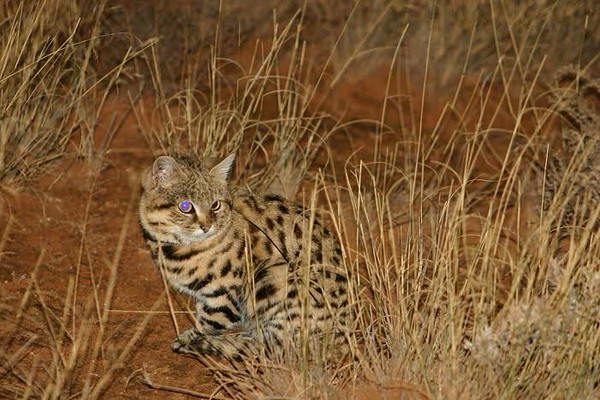
Black-footed cats are no bigger than your house cat, and probably smaller in most cases. They are only found in three countries: Botswana, Namibia and South Africa.
An incredibly tenacious little cat, the natives have a legend claiming these tiny cats can bring down a giraffe. While this is untrue, it pays homage to the determination of these feisty little felines.
Researchers often record interactions between black-footed cats and other animals in their habitat. Their attitude proves that while they may be small, they don’t let their size stop them!
“The male Kubu was located resting in a hollow termite mound. When he became active, he sprayed several times, then caught a gerbil. He continued to forage and as a group of bat-eared foxes three times the size of the cat approached, Kubu sat and watched them. When one of the foxes came too close, Kubu slapped him and just walked on.”
Or how about this determined kitty:
“I was following one of the black-footed cats when I drove past a blue crane nest I had been checking the past week. This time when I shone my spotlight on the big birds, I noticed the bright blue eyes of the male black-footed cat next to the nest. I watched as he sniffed the nesting female’s head and neck, then tried to push underneath her to get to the chicks in the nest.”
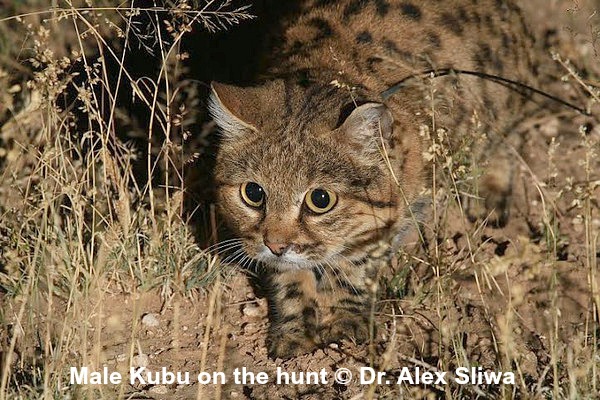
In addition to natural threats like black-backed jackals, caracals and eagle owls, these cats are increasingly being challenged by human changes to their habitat.
The average black-footed cat eats about 3,000 rodents each year. This should earn them the title of Farmer’s Friend, but they face many man-made threats:
-Poisoning of carcasses to kill larger carnivores, which the black-footed cats scavenge
-Overgrazing by livestock, which reduces their prey base
-Poisoning of locusts, which are eaten by the cats in huge numbers
-Killing by domestic dogs, which are used to chase or dig out jackals
With their population rapidly declining, this field project is vitally important so we can learn how to reverse this trend.
To study these nocturnal little felines, first you have to find them at night, in the vast desert. Team members drive a nightly route of up to 50 miles (80 km) along dirt roads at a speed under 18 mph (30 km) per hour while looking for the characteristic bright blue eye-shine of the cats. A minimum of two people stand on the open back of the vehicle operating two spotlights.
The project’s old 4×4 truck is on it’s last tires. With nearly 400,000 km of looking for black-footed cats on the odometer, it is spending more time in the costly repair shop than on the road.
When this truck stops working, the project stops learning about the cats. A new vehicle would cost more than $40,000 US but with your help, we can keep the cats under focus for half that price!
This is your chance to help us make a difference for these smallest of wild cats, and we ask for your support. Even if you’re not in a position to make a donation, please help us spread the word. Tell your friends, tell your family, share it on your social media, shout it from the rooftops, hire a skywriter… OK maybe not the last one, but you get the idea. Pass it on, and encourage your friends to do the same!
Please share this campaign wherever you can, and let everyone know you stand as a voice for the smallest of wild cats. Together, we CAN make a difference!